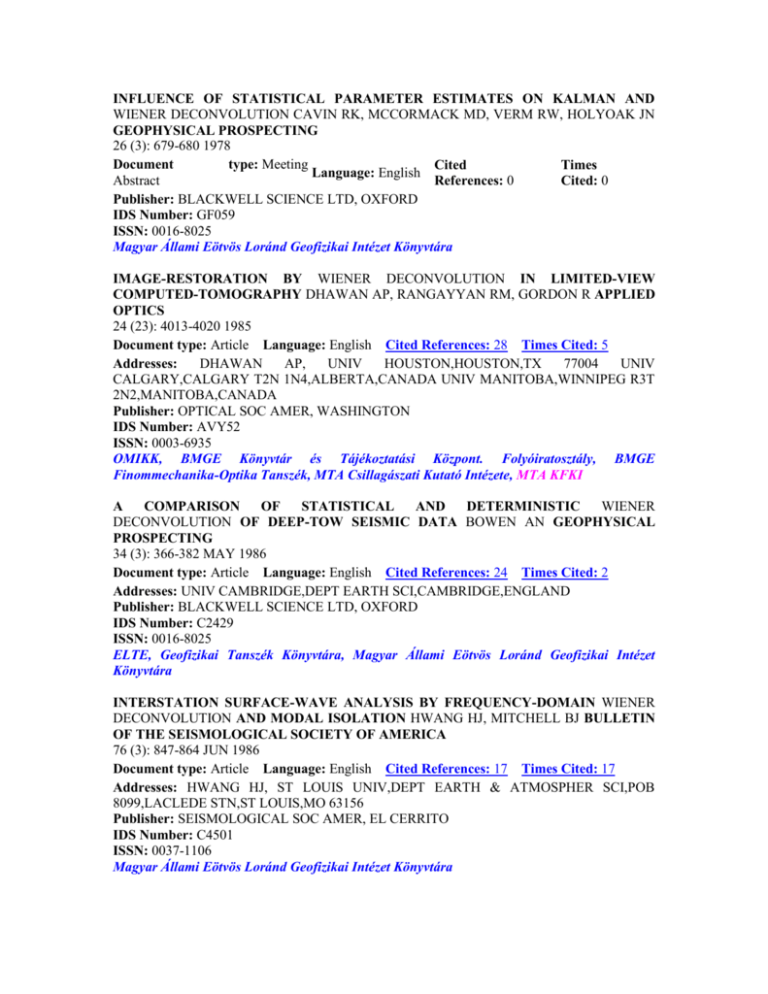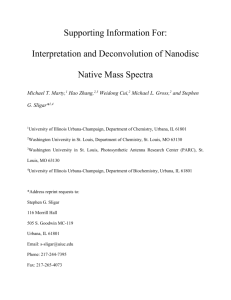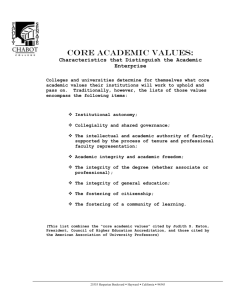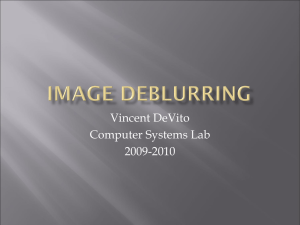
INFLUENCE OF STATISTICAL PARAMETER ESTIMATES ON KALMAN AND
WIENER DECONVOLUTION CAVIN RK, MCCORMACK MD, VERM RW, HOLYOAK JN
GEOPHYSICAL PROSPECTING
26 (3): 679-680 1978
Document
type: Meeting
Cited
Times
Language: English
Abstract
References: 0
Cited: 0
Publisher: BLACKWELL SCIENCE LTD, OXFORD
IDS Number: GF059
ISSN: 0016-8025
Magyar Állami Eötvös Loránd Geofizikai Intézet Könyvtára
IMAGE-RESTORATION BY WIENER DECONVOLUTION IN LIMITED-VIEW
COMPUTED-TOMOGRAPHY DHAWAN AP, RANGAYYAN RM, GORDON R APPLIED
OPTICS
24 (23): 4013-4020 1985
Document type: Article Language: English Cited References: 28 Times Cited: 5
Addresses:
DHAWAN
AP,
UNIV
HOUSTON,HOUSTON,TX
77004
UNIV
CALGARY,CALGARY T2N 1N4,ALBERTA,CANADA UNIV MANITOBA,WINNIPEG R3T
2N2,MANITOBA,CANADA
Publisher: OPTICAL SOC AMER, WASHINGTON
IDS Number: AVY52
ISSN: 0003-6935
OMIKK, BMGE Könyvtár és Tájékoztatási Központ. Folyóiratosztály, BMGE
Finommechanika-Optika Tanszék, MTA Csillagászati Kutató Intézete, MTA KFKI
A
COMPARISON
OF
STATISTICAL
AND
DETERMINISTIC
WIENER
DECONVOLUTION OF DEEP-TOW SEISMIC DATA BOWEN AN GEOPHYSICAL
PROSPECTING
34 (3): 366-382 MAY 1986
Document type: Article Language: English Cited References: 24 Times Cited: 2
Addresses: UNIV CAMBRIDGE,DEPT EARTH SCI,CAMBRIDGE,ENGLAND
Publisher: BLACKWELL SCIENCE LTD, OXFORD
IDS Number: C2429
ISSN: 0016-8025
ELTE, Geofizikai Tanszék Könyvtára, Magyar Állami Eötvös Loránd Geofizikai Intézet
Könyvtára
INTERSTATION SURFACE-WAVE ANALYSIS BY FREQUENCY-DOMAIN WIENER
DECONVOLUTION AND MODAL ISOLATION HWANG HJ, MITCHELL BJ BULLETIN
OF THE SEISMOLOGICAL SOCIETY OF AMERICA
76 (3): 847-864 JUN 1986
Document type: Article Language: English Cited References: 17 Times Cited: 17
Addresses: HWANG HJ, ST LOUIS UNIV,DEPT EARTH & ATMOSPHER SCI,POB
8099,LACLEDE STN,ST LOUIS,MO 63156
Publisher: SEISMOLOGICAL SOC AMER, EL CERRITO
IDS Number: C4501
ISSN: 0037-1106
Magyar Állami Eötvös Loránd Geofizikai Intézet Könyvtára
SEQUENTIAL WIENER DECONVOLUTION TO IMPROVE SEISMIC RESOLUTION
FERBER RG, KOITKA H GEOPHYSICAL PROSPECTING
39 (2): 183-191 FEB 1991
Document type: Article Language: English Cited References: 10 Times Cited: 2
Abstract: Two different techniques for performing time-variable Wiener deconvolution are
compared using stacked seismic data. The conventional technique involves the empirical division
of the data into a number of gates and the determination of time-invariant deconvolution filters
for each gate. In the second technique, the deconvolution filter is recomputed after each time
increment from a fixed-length data gate sliding along the trace. This scheme has the advantage
that no a priori segmentation of the data is needed.
Addresses: FERBER RG, PRAKLA SEISMOS AG,POB 51 30,W-3000 HANNOVER
51,GERMANY
Publisher: BLACKWELL SCIENCE LTD, OXFORD
IDS Number: EY117
ISSN: 0016-8025
ELTE, Geofizikai Tanszék Könyvtára, Magyar Állami Eötvös Loránd Geofizikai Intézet
Könyvtára
DEEP-STRUCTURE OF THE IBERIAN PENINSULA DETERMINED BY RAYLEIGHWAVE VELOCITY INVERSION BADAL J, CORCHETE V, PAYO G, SERON FJ, CANAS
JA, PUJADES L GEOPHYSICAL JOURNAL INTERNATIONAL
108 (1): 71-88 JAN 1992
Document type: Article Language: English Cited References: 38 Times Cited: 15
Abstract: A rigorous study of velocity dispersion of surface waves generated by teleseismic
events propagating across the Iberian Peninsula and traversing main geological units, has been
carried out from a set of selected analogue data, as digital records have only become available
recently. Dispersed seismic signals have been obtained over a period of 16 years, between 1967
and 1982, at the five Iberian stations having long-period instruments. In our study, we have
considered many earthquakes thus obtaining a fairly good path coverage of most of the peninsula
for two-station Rayleigh wave velocity measurements. In all cases, the approach azimuths of the
wavefronts were carefully checked. Several digital filtering techniques have been employed to
removed the effects of multipathing and modal contamination, and to isolate the fundamental
mode from Rayleigh wavetrains. Thus, we have obtained good estimates for both phase and
group velocities. A time-variable filter has reduced the influence of noise and removed higher
mode interference. Multiple filtering is then used to compute group velocity. Frequency-domain
Wiener deconvolution is used to compute the interstation phase velocity. The determined
average Rayleigh wave velocities reveal differences in the propagation conditions of the seismic
energy across the peninsula. A mapping of velocities for various periods of reference, together
with a mapping of errors in velocity, are the basis for obtaining the Rayleigh wave velocity
distribution in the peninsula. Theoretical 2-D layered earth models are obtained by joint inversion
of phase and group velocity dispersion curves using the stochastic inverse operator. In our
inversion scheme, we use velocities corrected for anelastic effects. Finally, a 3-D mapping of S
velocity is performed. This study shows important regional features of the deep structure of
Iberia; we see small lateral inhomogeneities and also two low-velocity layers: one with shear
velocities usually ranging from 4.23 to 4.31 km s-1 directly under the Moho, and another, the
asthenosphere, with a negative velocity gradient for depths between 81 and 181 km, terminated at
the bottom by a sharp discontinuity.
Author Keywords: DISPERSION, FILTERING, IBERIAN PENINSULA, INVERSION,
RAYLEIGH WAVES
KeyWords Plus: SURFACE-WAVE, UPPER MANTLE, DISPERSION, CRUST,
ANISOTROPY, PHASE
Addresses: BADAL J, UNIV ZARAGOZA,DEPT THEORET PHYS GEOPHYS,PLAZA SAN
FRANCISCO,E-50009 ZARAGOZA,SPAIN UNIV ZARAGOZA,HIGHER POLITECH CTR,E50015 ZARAGOZA,SPAIN POLITECH UNIV CATALUNYA,SCH CIVIL ENGN,E-08034
BARCELONA,SPAIN
Publisher: BLACKWELL SCIENCE LTD, OXFORD
IDS Number: GX547
ISSN: 0956-540X
ELTE, Geofizikai Tanszék Könyvtára, Magyar Állami Eötvös Loránd Geofizikai Intézet
Könyvtára
1ST 2-STATION RAYLEIGH-WAVE VELOCITY-MEASUREMENTS FOR THE
NORTHERN IBERIAN REGION PAYO G, CORCHETE V, BADAL J, SERON F, CANAS
JA, PUJADES L BULLETIN OF THE SEISMOLOGICAL SOCIETY OF AMERICA
82 (3): 1434-1452 JUN 1992
Document type: Article Language: English Cited References: 36 Times Cited: 13
Abstract: Up to now, dispersion analysis of surface waves across the Iberian Peninsula and
adjacent zones has been based on analog data recorded at the long-period Iberian stations. Also,
the northern region of the peninsula has never been investigated due to the lack of seismological
stations. With the ILIHA data set now available, it is possible to investigate the northern part of
Iberia from quality digital records. To efficiently remove higher-mode interference and to
improve isolation of the fundamental-mode Rayleigh wave from the seismograms, time-variable
filtering is employed. Once the signal is filtered, multiple filtering is then used to compute group
velocities at each station. The interstation Rayleigh-wave group velocity can thus be easily
calculated. Frequency-domain Wiener deconvolution is used to determine the interstation phase
velocity. We carried out inversion of velocity dispersion data containing both Rayleigh-wave
phase velocities and group velocities according to the generalized inversion theory by means of
the stochastic inverse operator. The theoretical 2-D Earth models determined by joint inversion
allow us to obtain for the first time the distribution of the shear-wave velocity both laterally and
with depth for the northern Iberian region, and to emphasize the main features of the crust-mantle
structure of this area.
KeyWords Plus: UPPER MANTLE STRUCTURE, SURFACE-WAVES, INVERSION,
PENINSULA, EUROPE, CRUST, ARRAY
Addresses: PAYO G, INST GEOGRAFICO NACL,OBSERV GEOFIS CENT,AP 446,E-45071
TOLEDO,SPAIN UNIV POLITECN CATALUNYA,DEPT INGN TERRENO,E-08034
BARCELONA,SPAIN
UNIV
ZARAGOZA,DEPT
FIS
TEOR
GEOFIS,E-50009
ZARAGOZA,SPAIN
Publisher: SEISMOLOGICAL SOC AMER, EL CERRITO
IDS Number: HY197
ISSN: 0037-1106
Magyar Állami Eötvös Loránd Geofizikai Intézet Könyvtára
SHEAR VELOCITY STRUCTURE BENEATH THE IBERIAN MASSIF FROM BROADBAND RAYLEIGH-WAVE DATA CORCHETE V, BADAL J, PUJADES L, CANAS JA
PHYSICS OF THE EARTH AND PLANETARY INTERIORS
79 (3-4): 349-365 SEP 1993
Document type: Article Language: English Cited References: 41 Times Cited: 8
Abstract: Up to a few years ago, dispersion analyses of surface waves across the Iberian
Peninsula and adjacent zones were based on analog data recorded at the long-period Iberian
stations. The installation of the NARS array on Iberian territory for a period of one year, has
provided a greater station density than was previously available with the very few permanent
long-period seismological stations installed on the peninsula. The NARS array also provided
quality digital records, and increased the path coverage for two-station surface wave velocity
measurements. Fundamental mode Rayleigh waves recorded at broadband stations belonging to
this array have been analyzed to produce phase and group velocity dispersion curves for the
period range 10-90 s. With the dataset now available, the elastic structure beneath the Iberian
Massif has been investigated in terms of the shear velocity distribution as a function of depth.
Time-variable filtering is employed to remove higher mode interference efficiently and to
improve isolation of the fundamental mode Rayleigh wave from the seismograms. Multiple
filtering is then used to compute group velocities at each station. The interstation Rayleigh wave
group velocity can thus be easily calculated. Frequency-domain Wiener deconvolution is used to
determine the interstation phase velocity. We perform inversion of velocity dispersion data
containing both Rayleigh wave phase velocities and group velocities according to the generalized
inversion theory by means of the stochastic inverse operator. The theoretical models for the lower
crust and uppermost mantle beneath the Iberian Massif obtained by joint inversion, show a
continental lithosphere with a thickness of 81 km. The crustal and subcrustal velocities are greater
than in other areas of the Iberian Peninsula. The asthenosphere appears as a layer 100 km thick
defined by very low velocities when compared with the rest of the peninsular area. Both the
lithosphere and the asthenosphere exhibit a low velocity channel. In the lithosphere a subcrustal
low velocity channel has velocity constrained between 4.33 and 4.62 km s-1. In the asthenosphere
the low velocity channel is constrained between 4.13 and 4.36 km s-1.
KeyWords Plus: UPPER MANTLE STRUCTURE, SURFACE-WAVES, INVERSION,
CRUST, INACCURATE, EUROPE, ARRAY
Addresses:
UNIV ZARAGOZA,DEPT THEORET PHYS GEOPHYS,E-50009 ZARAGOZA,SPAIN
UNIV POLITECN CATALUNA,SCH CIVIL ENGN,E-08034 BARCELONA,SPAIN
Publisher:
ELSEVIER SCIENCE BV, AMSTERDAM
IDS Number: LX217
ISSN: 0031-9201
ELTE, Geofizikai Tanszék Könyvtára, Magyar Állami Eötvös Loránd Geofizikai Intézet
Könyvtára
SHEAR-WAVE VELOCITY STRUCTURE BELOW THE IBERIAN PENINSULA AS
OBTAINED BY A DETAILED ANALYSIS OF SURFACE-WAVES BADAL J,
CORCHETE V, PAYO G, CANAS JA, PUJADES L TECTONOPHYSICS
225 (3): 167-190 OCT 15 1993
Document type: Article Language: English Cited References: 51 Times Cited: 12
Abstract: A tentative tomography of lberia based on broadband surface wave data is performed
for the first time. In this paper we have complemented a previous study of the northern half of the
lberian Peninsula with a study of the southern half of the peninsula based on a detailed analysis of
Rayleigh wave dispersion. Now we present the first shear velocity contour maps at different
subcrustal depths. Quality digital records provided by the NARS array have been used. Standard
techniques, as multiple filtering and time-variable filtering, are employed to efficiently remove
higher mode interference and improve isolation of the fundamental mode Rayleigh wave from the
seismograms, and thus to calculate the interstation Rayleigh wave group velocity. Frequencydomain Wiener deconvolution is used to determine the interstation phase velocity. We perform
simultaneous inversion of phase and group velocity dispersion data by means of the stochastic
inverse operator. The inversion results previously reported for the northern Iberian region
together with the results obtained here are used for 3-D mapping of shear wave velocity over the
Iberian Peninsula. Lateral variation in velocity at five depth intervals chosen in agreement with
the theoretical earth models determined by joint inversion, is displayed for the lithosphere and
asthenosphere of lberia.
KeyWords Plus: UPPER MANTLE STRUCTURE, CRUSTAL STRUCTURE, INVERSION,
RAYLEIGH,
ATTENUATION,
INACCURATE,
ANISOTROPY,
DISPERSION,
EVOLUTION, EUROPE
Addresses: BADAL J, UNIV ZARAGOZA,DEPT THEORET PHYS GEOPHYS,PL SAN
FRANCISCO,E-50009 ZARAGOZA,SPAIN NATL GEOGRAPH INST,CENT GEOPHYS
OBSERV,E-45071 TOLEDO,SPAIN POLITECH UNIV CATALUNYA,SCH CIVIL ENGN,E08034 BARCELONA,SPAIN
Publisher: ELSEVIER SCIENCE BV, AMSTERDAM
IDS Number: MC171
ISSN: 0040-1951
ELTE, Geofizikai Tanszék Könyvtára, Magyar Állami Eötvös Loránd Geofizikai Intézet
Könyvtára, OMIKK
MULTICHANNEL WIENER DECONVOLUTION OF VERTICAL SEISMIC PROFILES
HALDORSEN JBU, MILLER DE, WALSH JJ GEOPHYSICS
59 (10): 1500-1511 OCT 1994
Document type: Article Language: English Cited References: 9 Times Cited: 3
Abstract: We describe a technique for performing optimal, least-squares deconvolution of
vertical seismic profile (VSP) data. The method is a two-step process that involves (1) estimating
the source signature and (2) applying a least-squares optimum deconvolution operator that
minimizes the noise not coherent with the source signature estimate. The optimum inverse
problem, formulated in the frequency domain, gives as a solution an operator that can be
interpreted as a simple inverse to the estimated aligned signature multiplied by semblance across
the array. An application to a zero-offset VSP acquired with a dynamite source shows the
effectiveness of the operator in attaining the two conflicting goals of adaptively spiking the
effective source signature and minimizing the noise.
Signature design for seismic surveys could benefit from observing that the optimum
deconvolution operator gives a flat signal spectrum if and only if the seismic source has the same
amplitude spectrum as the noise.
Addresses: HALDORSEN JBU, GECO PRAKLA,BUCHHOLZERSTR 100,D-30655
HANNOVER 51,GERMANY SCHLUMBERGER CAMBRIDGE RES LTD,CAMBRIDGE
CB3 0EL,ENGLAND SCHLUMBERGER DOLL RES CTR,RIDGEFIELD,CT 06877
Publisher: SOC EXPLORATION GEOPHYSICISTS, TULSA
IDS Number: PK735
ISSN: 0016-8033
ELTE, Geofizikai Tanszék Könyvtára, Magyar Állami Eötvös Loránd Geofizikai Intézet
Könyvtára
LONGITUDINAL IMAGE DEBLURRING IN SPIRAL CT SCHLUETER FJ, WANG G,
HSIEH PS, BRINK JA, BALFE DM, VANNIER MW RADIOLOGY
193 (2): 413-418 NOV 1994
Document type: Article Language: English Cited References: 25 Times Cited: 7
Abstract: PURPOSE: To assess the feasibility of digital deconvolution techniques to improve
longitudinal resolution of spiral computed tomography (CT) multiplanar reformations and
evaluate how technical factors in deconvolution affect longitudinal resolution, noise, and edge
ringing.
MATERIALS AND METHODS: Longitudinal line spread function (LSF) of the system was
estimated from longitudinal reformations of trans-axial spiral CT images of a step test phantom.
By using the estimated LSF, longitudinal reformations of the phantom and three clinical spiral CT
studies were deconvolved by the methods of Wiener filtering and constrained iterative
deconvolution. Edge ringing and image noise were quantified for Wiener filtering and
constrained iterative deconvolution.
RESULTS: Longitudinal reformations were substantially deblurred and resolution improved after
deconvolution. Anatomic boundaries in clinical images were more clearly delineated after
restoration. The methods of Wiener deconvolution and constrained iterative deconvolution
improved the sharpness of the phantom step boundary at the expense of increased edge ringing
and image noise.
CONCLUSION: In longitudinal spiral CT reformations, blurring along the longitudinal axis can
be reduced by Wiener filtering or constrained iterative deconvolution.
Author Keywords: COMPUTED TOMOGRAPHY (CT), HELICAL TECHNOLOGY,
COMPUTED TOMOGRAPHY (CT), IMAGE PROCESSING, COMPUTED TOMOGRAPHY
(CT), PHYSICS
KeyWords Plus: VOLUMETRIC CT, 3 DIMENSIONS, RESOLUTION, MICROSCOPY,
ABDOMEN, NOISE
Addresses: SCHLUETER FJ, WASHINGTON UNIV,SCH MED,MALLINCKRODT INST
RADIOL,510 S KINGSHIGHWAY BLVD,ST LOUIS,MO 63110
Publisher: RADIOLOGICAL SOC NORTH AMER, EASTON
IDS Number: PN947
ISSN: 0033-8419
Semmelweis Egyetem. Központi Könyvtár, Semmelweis Egyetem. Radiológiai és Onkoterápiás
Klinika Orvosi Könyvtára, Semmelweis Egyetem. Kútvölgyi Klinikai Tömb Orvosi Könyvtára
WALK-AWAY VSP USING DRILL NOISE AS A SOURCE HALDORSEN JBU, MILLER
DE, WALSH JJ GEOPHYSICS
60 (4): 978-997 JUL-AUG 1995
Document type: Article Language: English Cited References: 10 Times Cited: 6
Abstract: We describe a method for extracting and deconvolving a signal generated by a drill bit
and collected by an array of surface geophones. The drill-noise signature is reduced to an
effective impulse by means of a multichannel Wiener deconvolution technique, producing a
walk-away reverse vertical seismic profile (VSP) sampled almost continuously in depth. We
show how the multichannel technique accounts for noise and for internal drill-string reflections,
automatically limiting the deconvolved data to frequencies containing significant energy.
We have acquired and processed a data set from a well in Germany while drilling at a depth of
almost 4000 m. The subsurface image derived from these data compares well with corresponding
images from a 3-D surface seismic survey, a zero-offset VSP survey, and a walk-away VSP
survey acquired using conventional wireline techniques. The effective bandwidth of the
deconvolved drill-noise data is comparable to the bandwidth of surface seismic data but
significantly smaller than what can be achieved with wireline VSP techniques.
Although the processing algorithm does not require the use of sensors mounted on the drill string,
these sensors provide a very economic way to compress the data. The sensors on the drill string
were also used for accurate timing of the deconvolved drill-noise data.
KeyWords Plus: BIT
Addresses: HALDORSEN JBU, SCHLUMBERGER DOLL RES CTR,OLD QUARRY
RD,RIDGEFIELD,CT 06877 SCHLUMBERGER WELL SERV,HOUSTON,TX 77077 GECO
PRAKLA,D-30655 HANNOVER,GERMANY
Publisher: SOC EXPLORATION GEOPHYSICISTS, TULSA
IDS Number: RH460
ISSN: 0016-8033
ELTE, Geofizikai Tanszék Könyvtára, Magyar Állami Eötvös Loránd Geofizikai Intézet
Könyvtára
Application of a 3D volume F-19 MR imaging protocol for mapping oxygen tension (pO(2))
in perfluorocarbons at low field Pratt RG, Zheng J, Stewart BK, Shiferaw Y, McGoron AJ,
Samaratunga RC, Thomas SR MAGNETIC RESONANCE IN MEDICINE
37 (2): 307-313 FEB 1997
Document type: Article Language: English Cited References: 25 Times Cited: 6
Abstract: A limited flip angle gradient-echo 3D volume acquisition imaging protocol for
mapping partial pressure of oxygen (pO(2)) in perfluorocarbon compounds (PFCs) at tow field
(0.14 T) is presented. The pO(2) measurement method is based on the paramagnetic effect of
dissolved molecular oxygen (O-2) which reduces the PFC F-19 T-1. Specific objectives related to
imaging of PFCs through use of the protocol include improved image signal-to-noise
characteristics and elimination of F-19 chemical shift artifacts. A parametric Wiener
deconvolution filtering algorithm is used for suppression of F-19 chemical shift artifacts.
Application of the protocol is illustrated in a series of calculated pO(2) maps of a gas
equilibrated, multi-chamber phantom containing perfluorotributylamine (FC-43). The utility of
the protocol is demonstrated in vivo through images of a commercially available perfluorocarbon
based blood substitute emulsion containing FC-43 sequestered in the liver and spleen of a rat.
Author Keywords: fluorine-19 magnetic resonance imaging, volume acquisition, oxygen
imaging, spectral deconvolution
KeyWords Plus: MAGNETIC-RESONANCE SPECTROSCOPY, CHEMICAL-SHIFT, NMR,
RELAXATION, TISSUES, BLOOD
Addresses: Pratt RG, UNIV CINCINNATI,MED CTR,DEPT RADIOL,DIV MED PHYS,231
BETHESDA AVE,ROOM E560,POB 670579,CINCINNATI,OH 45267 UNIV IOWA HOSP &
CLIN,DEPT
RADIOL,IOWA
CITY,IA
52242
UNIV
WASHINGTON,DEPT
RADIOL,SEATTLE,WA 98195 NIH,IN VITRO NMR RES CTR,CINCINNATI,OH
Publisher: WILLIAMS & WILKINS, BALTIMORE
IDS Number: WD272
ISSN: 0740-3194
Debreceni Egyetem. Orvos és Egészségtudományi Centrum. Központi Kenézy Könyvtár
Resolution improvement of ultrasonic C-scan images by deconvolution using the monostatic
point-reflector spreading function (MPSF) of the transducer Cheng SW, Chao MK NDT & E
INTERNATIONAL
29 (5): 293-300 OCT 1996
Document type: Article Language: English Cited References: 11 Times Cited: 5
Abstract: This paper describes a digital signal processing method called 'post-focus processing'.
The method reduces the transducer blurring effect and improves the resolution of ultrasonic Cscan images by simultaneously performing 3-D (2-D spatial and temporal) deconvolution using
the MPSF (monostatic point-reflector spreading function) of the transducer. This method was
applied under different imaging conditions, including the near-field and far-field of non-focused
transducers and the defocused state of a focused transducer. In order to compare the proposed
technique with other deconvolution methods, results from numerical simulations and experiments
are presented. The results of numerical simulations of C-scan imaging with post-focus processing
and 2-D Wiener deconvolution are reported. Experiments were conducted using post-focus
processing and three known image resolution improving methods including axial-Wiener
deconvolution, 2-D Wiener deconvolution and pseudo 3-D Wiener deconvolution. Results
show the MPSF is a crucial blurring factor affecting the image resolution of C-scan images, and
the post-focus processing method is more effective and generally applicable than the others.
Copyright (C) 1996 Elsevier Science Ltd.
Author Keywords: C-scan, image resolution, deconvolution, post-focus processing
Addresses: Cheng SW, NATL TAIWAN UNIV,INST NAVAL ARCHITECTURE & OCEAN
ENGN,73 CHOU SHAN RD,TAIPEI 10764,TAIWAN
Publisher: ELSEVIER SCI LTD, OXFORD
IDS Number: WD756
ISSN: 0963-8695
OMIKK, BMGE Könyvtár és Tájékoztatási Központ. Folyóiratosztály
Deconvolution of impulse response in event-related BOLD fMRI Glover GH
NEUROIMAGE
9 (4): 416-429 APR 1999
Document type: Article Language: English Cited References: 24 Times Cited: 53
Abstract: The temporal characteristics of the BOLD response in sensorimotor and auditory
cortices were measured in subjects performing finger tapping while listening to metronome
pacing tones. A repeated trial paradigm was used with stimulus durations of 167 ms to 16 s and
intertrial times of 30 s. Both cortical systems were found to be nonlinear in that the response to a
long stimulus could not be predicted by convolving the 1-s response with a rectangular function.
In the short-time regime, the amplitude of the response varied only slowly with stimulus duration.
It was found that this character was predicted with a modification to Buxton's baboon model.
Wiener deconvolution was used to deblur the response to concatenated short episodes of finger
tapping at different temporal separations and at rates from 1 to 4 Hz. While the measured
response curves were distorted by overlap between the individual episodes, the deconvolved
response at each rate was found to agree well with separate scans at each of the individual rates.
Thus, although the impulse response cannot predict the response to fully overlapping stimuli,
linear deconvolution is effective when the stimuli are separated by at least 4 s. The deconvolution
filter must be measured for each subject using a short-stimulus paradigm. It is concluded that
deconvolution may be effective in diminishing the hemodynamically imposed temporal blurring
and may have potential applications in quantitating responses in event-related fMRI. (C) 1999
Academic Press.
KeyWords Plus: BRAIN ACTIVATION, AUDITORY-CORTEX, FUNCTIONAL MRI,
BLOOD-FLOW, OXYGENATION, DYNAMICS, MODEL, TASK
Addresses: Glover GH, Stanford Univ, Sch Med, Dept Diagnost Radiol, Ctr Adv MR Technol
Stanford, Stanford, CA 94305 USA Stanford Univ, Sch Med, Dept Diagnost Radiol, Ctr Adv MR
Technol Stanford, Stanford, CA 94305 USA
Publisher: ACADEMIC PRESS INC, SAN DIEGO
IDS Number: 188TB
ISSN: 1053-8119
???
An H-infinity deconvolution filter and its application to ultrasonic nondestructive
evaluation of materials Hanshaw TC, Anderson MJ, Hsu CS ISA TRANSACTIONS
38 (4): 323-335 1999
Document type: Article Language: English Cited References: 12 Times Cited: 0
Abstract: Deconvolution can be a valuable technique for interpreting results of ultrasonic
nondestructive evaluation (NDE) tests of materials. This is especially true for state of the art
hybrid materials. In this paper, a new H-infinity deconvolution filter is presented. The filter is
applied to typical ultrasonic NDE data, including through-transmission data for aluminum and
composite samples. The results are compared to those obtained from a Wiener deconvolution
filter. The performance of the H-infinity filter is as good or better than the performance of the
Wiener filter. (C) 1999 Elsevier Science Ltd. All rights reserved.
Author Keywords: bounded real lemma, H-infinity deconvolution filter, nondestructive
evaluation of materials
KeyWords Plus: EIGENSYSTEM REALIZATION-ALGORITHM, SYSTEMS
Addresses: Hsu CS, Washington State Univ, Sch Elect Engn & Comp Sci, Pullman, WA 99164
USA Washington State Univ, Sch Elect Engn & Comp Sci, Pullman, WA 99164 USA
Publisher: ELSEVIER SCIENCE BV, AMSTERDAM
IDS Number: 264HT
ISSN: 0019-0578
BMGE Könyvtár és Tájékoztatási Központ. Folyóiratosztály
Resolution improvement of ERS scatterometer data over land by Wiener filtering AlvarezPerez JL, Marshall SJ, Gregson K REMOTE SENSING OF ENVIRONMENT
71 (3): 261-271 MAR 2000
Document type: Article Language: English Cited References: 29 Times Cited: 1
Abstract: Multiplicative Wiener deconvolution has been applied to ERS scatterometer
measurements obtained over land with the aim of improving their spatial resolution. The ERS
scatterometer teas launched to provide high-accuracy radar backscattering measurements over the
sea surface for the purpose of monitoring marine wind velocity However, ERS scatterometer data
soon inspired an increasing interest for land and sea ice monitoring. The main shortcoming of
these applications has been the coarse resolution of the device. This varies between 25 km(2) and
46 km(2) before ground processing, which results in normalization dozen to similar to 48 km(2)
so that all the measurements can be used jointly in the wind vector retrieval . Nevertheless, for the
case of perdurable sea ice and land scenes, measurements with 25-km resolution before ground
processing can be selected to form images. As will be shown here, this finer resolution can be
recovered for these images by using a linear Wiener filter. This restoration technique teas tested
on a large scene from Russia. The improvement can be observed in the definition of the line of
the river of the basin. (C) Elsevier Science Inc., 2000.
KeyWords Plus: WIND SCATTEROMETER, ENHANCEMENT, VEGETATION,
SURFACES
Addresses: Alvarez-Perez JL, Univ Nottingham, Environm SC Div, Loughborough LE12 5RD,
Leics, England Univ Nottingham, Environm SC Div, Loughborough LE12 5RD, Leics, England
Publisher: ELSEVIER SCIENCE INC, NEW YORK
IDS Number: 287HX
ISSN: 0034-4257
Földmérési és Távérzékelési Intézet Könyvtára
Time-domain approaches to multichannel optimal deconvolution Deng ZL
INTERNATIONAL JOURNAL OF SYSTEMS SCIENCE
31 (6): 787-796 JUN 2000
Document type: Article Language: English Cited References: 14 Times Cited: 0
Abstract: Using the modern time series analysis method, based on the autoregressive moving
average (ARMA) innovation model and white noise estimators, two time-domain approaches to
multichannel optimal deconvolution are presented. In the first approach, the multichannel optimal
deconvolution estimators are given in the ARMA innovation filters form, where the solution of
the Diophantine equations is required. Their global and local asymptotic stability is proved. In the
second approach, the multichannel ARMA recursive Wiener deconvolution filters without the
Diophantine equations are presented, which have asymptotic stability. The relationship between
the ARMA innovation filters and ARMA Wiener deconvolution filters is discussed. Each
approach can handel the deconvolution filtering, smoothing and prediction problems in a unified
framework. An illustrative example and two simulation examples show their effectiveness.
KeyWords Plus: POLYNOMIAL METHODS, FILTERS
Addresses: Deng ZL, Heilongjiang Univ, Inst Appl Math, POB 229, Harbin 150080, Peoples R
China Heilongjiang Univ, Inst Appl Math, Harbin 150080, Peoples R China
Publisher: TAYLOR & FRANCIS LTD, LONDON
IDS Number: 327TH
ISSN: 0020-7721
???
Optimum primary and supplementary signals optimizing the seismic data resolution
Tyapkin YK JOURNAL OF APPLIED GEOPHYSICS
46 (3): 175-187 MAR 2001
Document type: Article Language: English Cited References: 19 Times Cited: 1
Abstract: Often in practice, when generating seismic waves on a line, even with a wide-band
source, numerous natural and technical obstacles cause a low resolution of reflection
seismograms. In this case, the economy of the survey should be taken into consideration and
rather than ignoring preexisting data, generating additional signal to complement the preexisting
data should be tried. This paper describes how this can be done to optimize the resolution of the
combined data. The new approach requires a fundamental change in the field technique such that
records with different spectral characteristics (RDSC) are now generated from each sourcereceiver pair. These coincident records share a common reflectivity series, but differ from each
other in wavelets and noise. A comprehensive theory for optimum processing (deconvolution) of
any available suite of the RDSC is developed. The solution for the problem is a particular case of
multichannel Wiener filtering. It can be thought of as two successive procedures. The first is
optimum frequency-dependent weighted stacking of the RDSC. The second is single-channel
zero-phase Wiener deconvolution filtering of the previous output. This representation enables
suggested multichannel filtering to be easily implemented. The effectiveness of the method as
well as its advantage over straight summing of the RDSC, followed by single-channel Wiener
deconvolution filtering, are corroborated theoretically and demonstrated with field data.
Furthermore, a solution is suggested fbr the problem to evaluate the spectrum of an optimum
supplementary signal. The signal contributes to the available set of the RDSC and yields either
maximum resolution with limited energy expenses or a certain desired resolution with minimum,
but unrestricted energy expenses at the output of the optimum procedure. The optimum
distribution of the spectral energy of a primary signal along the frequency axis is a particular case
of the above problem with no preexisting data. (C) 2001 Published by Elsevier Science B.V.
Author Keywords: deconvolution, resolution, seismic wavelet, Wiener filter, multichannel filter
KeyWords Plus: SIGNATURE
Addresses: Tyapkin YK, Ukrainian State Geol Prospecting Inst, 78 Avtozavodskaya St, UA04114 Kiev, Ukraine Ukrainian State Geol Prospecting Inst, UA-04114 Kiev, Ukraine
Publisher: ELSEVIER SCIENCE BV, AMSTERDAM
IDS Number: 420JB
ISSN: 0926-9851
???
De-noising techniques for terahertz responses of biological samples Ferguson B, Abbott D
MICROELECTRONICS JOURNAL
32 (12): 943-953 DEC 2001
Document type: Article Language: English Cited References: 36 Times Cited: 4
Abstract: Signal processing techniques may be used to improve the speed, resolution and noise
robustness of pulsed terahertz (T-ray) imaging systems. Such systems have a wide range of
applications and much recent interest has focussed on several promising biomedical fields. There
are a number of significant challenges to be overcome before a commercial biomedical terahertz
system can be realised. Recent research is focussed on the implementation of a high speed,
compact and portable T-ray imaging system. This system will draw heavily on MOEMS
technology. One of the major stages in the development of such a system is the design of efficient
software algorithms to perform signal recognition and imaging operations in real time.
This paper considers a number of signal processing techniques suitable for de-noising and
extracting information from the data obtained in a terahertz pulse imaging system. Two main denoising techniques are considered. Wavelet de-noising and Wiener deconvolution algorithms are
applied to the terahertz responses of biological samples including Spanish Serrano ham and an
oak leaf. (C) 2001 Elsevier Science Ltd. All rights reserved.
Author Keywords: terahertz, T-ray imaging, wavelet de-noising, Wiener deconvolution
KeyWords Plus: TIME-DOMAIN SPECTROSCOPY, SYSTEM
Addresses: Ferguson B, Univ Adelaide, Ctr Biomed Engn, Dept Elect & Elect Engn, Adelaide,
SA 5005, Australia Univ Adelaide, Ctr Biomed Engn, Dept Elect & Elect Engn, Adelaide, SA
5005, Australia CRC Sensor Signal & Informat Proc, Adelaide, SA 5095, Australia
Publisher: ELSEVIER ADVANCED TECHNOLOGY, OXFORD
IDS Number: 495UG
ISSN: 0026-2692
???
Restoration of broadband imagery steered with a liquid-crystal optical phased array
Weinschenk JJ, Hardie RC, Harris SR OPTICAL ENGINEERING
41 (10): 2613-2619 OCT 2002
Document type: Article Language: English Cited References: 11 Times Cited: 0
Abstract: In many imaging applications, it is highly desirable to replace mechanical beamsteering components (i.e., mirrors and gimbals) with a nonmechanical device. One such device is
a nematic liquid crystal optical phased array (LCOPA). An LCOPA can implement a blazed
phase grating to steer the incident light. However, when a phase grating is used in a broadband
imaging system, two adverse effects can occur. First, dispersion will cause different incident
wavelengths arriving at the same angle to be steered to different output angles, causing chromatic
aberrations in the image plane. Second, the device will steer energy not only to the first
diffraction order, but to others as well. This multiple-order effect results in multiple copies of the
scene appearing in the image plane. We describe a digital image restoration technique designed to
overcome these degradations. The proposed postprocessing technique is based on a Wiener
deconvolution filter. The technique, however, is applicable only to scenes containing objects
with approximately constant reflectivities over the spectral region of interest. Experimental
results are presented to demonstrate the effectiveness of this technique. (C) 2002 Society of
Photo-Optical Instrumentation Engineers.
Author Keywords: optical phased array, broadband, image steering, image restoration
KeyWords Plus: DISPERSION
Addresses: Weinschenk JJ, Univ Dayton, Dept Elect & Comp Engn, 300 Coll Pk, Dayton, OH
45409 USA Univ Dayton, Dept Elect & Comp Engn, Dayton, OH 45409 USA USAF, Res Lab,
Electro Opt Technol Div, AFRL,SNJM, Wright Patterson AFB, OH 45433 USA
Publisher: SPIE-INT SOCIETY OPTICAL ENGINEERING, BELLINGHAM
IDS Number: 606BU
ISSN: 0091-3286
???
Optimum pilot sweep Tyapkin YK, Robinson EA GEOPHYSICAL PROSPECTING
51 (1): 15-22 JAN 2003
Document type: Article Language: English Cited References: 12 Times Cited: 0
Abstract: The successful application of high-resolution seismic methods requires evaluating each
element in the seismic system and ensuring that each part of the system contributes optimally to
the success of the method. Unfortunately, unlike data processing, seismic signal generation is not
carefully optimized. The purpose of our study was to optimize the source signal in order to better
coordinate field operations with subsequent data processing to achieve their common objective.
We developed an iterative method for a rational frequency distribution of the energy of a seismic
source. The method allows the optimum amplitude spectrum of a source signal to be calculated,
thus providing the best data quality at the end of the processing. We assume that the source signal
is affected by a total transfer function, by the reflectivity function of a target interval, and by
ambient noise, whose characteristics, if not known, can be estimated or measured in practice. The
transfer function includes data processing other than the correlation stage and the final traceoptimizing filter. The variance of a reflectivity estimate is considered to be a measure of the data
quality and improvement of the characteristic corresponds to a decrease in the variance. For this
reason, a constrained Wiener deconvolution filter is used as the final trace-optimizing filter. It
not only minimizes the variance of a reflectivity estimate but also ensures a specific signal-tonoise ratio. The method is made feasible by following the Vibroseis technique, primarily because
of the versatility of the technique in controlling the signal spectrum. With the optimum amplitude
spectrum obtained, the corresponding optimum pilot sweep can be readily calculated. Examples
using synthetic data are presented to illustrate the method.
Addresses: Tyapkin YK, Ukrainian State Geol Prospecting Inst, 78 Avtozavodskaya St, UA04114 Kiev, Ukraine Ukrainian State Geol Prospecting Inst, UA-04114 Kiev, Ukraine Columbia
Univ, New York, NY 10069 USA
Publisher: BLACKWELL PUBLISHING LTD, OXFORD
IDS Number: 637TG
ISSN: 0016-8025
???








